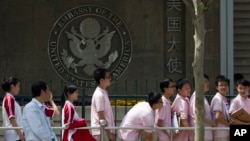Student Union
Colleges Make Heart-Breaking Cuts to Sports Teams Amid COVID
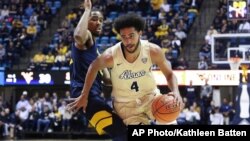
Carlos Tercero had already been forced to move in with one of his teammates when St. Edward's University closed its campus because of the pandemic, their seasons cut short like so many others across the nation.
Tercero and fellow golfer Nico Ciavaglia were adjusting to online classes off campus when things got even worse: The seniors-to-be have no team to return to next season.
The small school in Austin, Texas, slashed five teams from its successful Division II athletics programs: men's and women's golf, men's and women's tennis and men's soccer, while also downgrading its cheer squad to a club sport.
They were easily among the most drastic sports cuts among NCAA schools so far as higher education administrators across the nation face a devastating financial blow from the pandemic. St. Edward's is among five Division II schools known to have shut down athletic programs or drop individual programs since March 1, according to Associated Press research.
Urbana University in Ohio, which had a 19-sport Division II program, announced last month that the school would close by summer. Notre Dame De Namur in California has eliminated its 12-sport program. Sonoma State in California dropped women's water polo, along with men's and women's tennis; and Fayetteville State in Arkansas dropped women's tennis.
Only five total teams have been eliminated in cuts by four Division I schools, though the pace could pick up. And all of the decisions are hitting athletes hard.
"To have that ripped away from us so abruptly was just heartbreaking," Ciavaglia said.
Head coaches of the affected teams, who have been to NCAA tournaments and won conference titles, say they were blindsided with the news during a Zoom meeting with St. Edward's administrators on April 15 that lasted only a few minutes.
"They chopped our heads before we knew we were being accused of a crime," said Estevam Strecker, the men's tennis coach who had four All-Americans on his sixth-ranked team this spring.
An online petition started by Ciavaglia and Tercero to save the programs has received thousands of signatures. The school, which does not have a football team, has about 4,300 students.
After a series of meetings, administrators offered a daunting, long-shot chance: Each program would have to raise enough money by the end of May to cover five years of operational costs: $2.3 million for the golf teams, $2.2 million for men's soccer, $2 million for the tennis teams and $800,000 for cheer. They would then have to raise another $50 million or so over the next five years to fully endow the teams; the school's current overall endowment is about $110 million.
All of that wouldn't even fund any scholarships for athletes on those teams; most of the more than 300 athletes receive some form of athletic, academic or need-based aid. The total cost of attendance for the 2020-2021 school year for a student will be about $66,000.
Administrators declined comment, issuing a statement that said St. Edward’s "will not compromise our student-athletes by running programs that are not properly funded" and noted it had outlined a financial pathway to reinstatement. Athletic director Debbie Taylor acknowledged to the Austin American, "It's going to be very challenging" for the programs to raise that kind of money.
The St. Edward's campus is about eight kilometers from the University of Texas, which has one of the biggest and most expensive Division I athletic programs, annually generating well over $200 million in revenue. St. Edward's operated its entire athletic program for about $9 million in 2018-2019, according to federal records.
School President George Martin wrote in a letter to students that the school is bracing for major budget cuts, citing several million dollars in lost revenue after refunds to students for housing, meals and other fees. There is a projected 12% decline in enrollment and revenue for the next school year.
For Strecker, life has become a balance of confidence and despair, though he intends to proceed in the same way he has always coached his players: to never quit trying.
"On top of that, I'm try to balance we're in the middle of a pandemic," he said. "There are 30 million people that lost their jobs ... and here we are about to call people and ask for money to save a tennis program."
Strecker said he has raised about $8,000 per year, easily covering any amount that he might have gone over budget. The tennis program is now being asked to raise $2 million in 30 days and another $16.2 million the next five years.
St. Edward's is the only one of the 19 schools in the Lone Star Conference to cut any teams so far. The school will be down to the minimum 10 teams necessary for Division II status unless some, or all, of the programs are restored.
"There is some optimism, although I think me and my teammates are now resigned to the decision, given that the university doesn't seem to value our program and hastily cut it along with the five others," said George Murray, a senior-to-be soccer player who finished his semester online after going home to England.
Murray is among about 60 athletes from the five teams with eligibility remaining. St. Edward's will honor any athletic scholarships for the duration of their undergraduate enrollment or grant immediate release to any who prefer to transfer.
Ciavaglia and Tercero both said they likely will remain at St. Edward's to finish their degrees as quickly as possible. Tercero, who is from Mexico, would lose credits toward his business degree and some scholarship money if he transferred to keep playing. He said he would also have to get his visa changed.
"I'm trying to finish school," Tercero said. "So the school has put us in a very hard situation of basically making us stay at the school."
See all News Updates of the Day
- By Dylan Ebs
International students find community during Pride Month
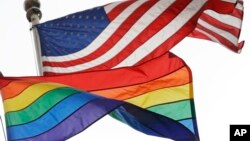
For LGBTQ+ international students, Pride Month, observed in June, is a unique time to reflect.
They hold on to multiple identities — both their LGBTQ+ identity and their cultural background — but coming to terms with them is not always easy.
For graduate student David Zhou, these identities can feel conflicting as transgender rights in China remain a controversial issue and spaces for LGBTQ people close. Zhou, 25, is transgender and pursuing an education in the STEM field at an urban university in the Midwestern United States.
VOA is using a pseudonym for Zhou’s first name and is not naming his university to protect his identity due to safety concerns back home in China. Zhou is not open about his transgender identity to his family.
During Pride Month, Zhou said he attended multiple LGBTQ+ events in his community and is surrounded by a supportive group of LGBTQ+ students who can relate to his experiences. But he’s not open about his identity to everyone on campus and said he doesn’t disclose his preferred pronouns to everyone to avoid transphobic comments.
“I feel like I have to make some judgments of the character of that person to see if they’re a good person to disclose [my identity] to,” Zhou said.
Zhou’s Pride Month celebrations included attending local markets with LGBTQ+ vendors and hanging out with his LGBTQ+ friends.
“They normalized being trans and for a long time I feel like trans identity is, should I say a vulnerability, brings me fear and worrying about discrimination, but having those events are helpful because it allowed me to see that queer people could just [live] openly,” he said.
At social events where few international students are present, Zhou said it can be tough to fit in.
“There's a lot of times like when they were talking about things I kind of, don't really understand, mostly because I kind of lack some background experience or knowledge,” he said.
Zhou said he is not aware of specific groups for LGBTQ+ international students at his university, but said international students are more prevalent in graduate programs and therefore find representation in organizations for LGBTQ+ graduate students.
In China, transgender individuals must obtain consent from an “immediate family member,” even for adults hoping to transition, which critics say limits the autonomy of transgender individuals while supporters say the policy protects doctors from violence by upset parents.
Struby Struble, a former coordinator of the University of Missouri LGBTQ+ Resource Center, told NAFSA: Association of International Educators in 2015 that LGBTQ+ international students face a “double barrier” on campus.
“With their international student friends, they feel isolated because they’re the LGBT one,” she said. “But then among the LGBT students on campus, they feel isolated because they’re the international one.”
Nick Martin, associate director of the Q Center, Binghamton University’s LGBTQ+ student support office, said when international students tour the center, there’s often a sense of hesitation as they enter a type of space that may not be present in their home country.
“I compare that to a year in after they've come into the space, they've again, maybe come to some of our events, they've got more connected,” he said.
Martin said graduate students have a unique interest in the Q Center as they may use the office for research and advocacy purposes that align with their studies.
“For older students, there may be hesitancy in a different way, but I think it's more in the vein of they want to do some of the advocacy work,” he said.
Martin said he thinks about how both his office and BU’s international student office can support students who come from countries with few — if any — protections for LGBTQ+ individuals.
“It's been a learning process of what those students really need, but I think I've kind of learned that a lot of students are just looking for the safe space that we offer,” Martin said.
- By VOA News
International students discuss US campus culture shock

International students at De Anza College in Cupertino, California, talked about culture shock in an article in La Voz News, the student newspaper.
"It felt like a major culture shock. Everything was so different, from academics to mannerism," said a student from Mexico.
Read the full story here.
These are the most expensive schools in the US

High tuition costs along with housing and food expenses can add up for students at U.S. colleges and universities.
MSNBC looked at the most expensive schools in the country, with one costing more than $500,000 for a bachelor’s degree. (June 2024)
Uzbekistan students admitted into top US universities
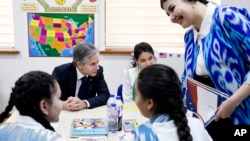
Students from Uzbekistan are among the international students admitted to top colleges and universities in recent years.
Gazata.uz profiled some of the Uzbekistan students attending Harvard, Brown, Princeton and other U.S. universities. (June 2024)
- By Stella Hsu
Reports of visa checks, deportations worry Chinese STEM students in US
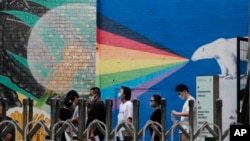
Geopolitical tensions and growing competition in tech between the United States and China appear to be spilling over into academia despite commitments from the world’s two biggest economies to boost people-to-people exchanges.
The United States remains the top choice for Chinese students seeking to study abroad with nearly 300,000 studying in American colleges and universities during the 2022-2023 school year. But reports of some cases that students and professors are facing extra scrutiny while passing through immigration and the deportation of others are raising concerns.
For Chen Xiaojin, a doctoral student studying semiconductor materials at a university in the Washington, D.C., metropolitan area, it has been six years since she returned to her hometown of Beijing.
At first, it was the COVID-19 pandemic that kept her from going home. But over the past two years, she has been deterred by accounts of Chinese students majoring in science and engineering being required to reapply for their visas upon returning to China.
She also says she is worried by reports over the past six months of Chinese students being deported, even at nearby Dulles Airport.
"My current research is relatively sensitive, and my boss [adviser] is getting funds from the U.S. Department of Defense, making it even more sensitive,” she told VOA. "I am afraid that I won't be able to return after I go back [to China]."
Chen says that if she did return to China, she would have to apply for a new visa.
In a report late last month, Bloomberg said it had found at least 20 Chinese students and scholars with valid visas who were deported at U.S. Customs since November and barred from reentry. The U.S. Customs and Border Protection Agency does not release relevant data.
Immigration attorney Dan Berger represented one Chinese student who was deported late last year. He tells VOA Mandarin that the student studied biological sciences at Yale University and was about to complete her doctorate.
She visited her family in China and got a new visa but was deported by customs at Dulles Airport and barred from reentering the country for five years. Berger said he did not see anything suspicious in the transcript of the conversation between the student and the customs officer.
"We have seen what seems like a pattern over the last six months of Chinese PhD students being turned around…. more than I've seen in quite a while," he said.
Matthew Brazil, a fellow at the Jamestown Foundation, said neither country seems willing to explain the situation. However, he believes that in most cases, the United States must have valid reasons for blocking visa holders from entering the country.
In some cases, the student’s background may not match what is written on the visa application. In other cases, customs agents may also find something that the State Department missed, and once they see it, they are responsible for taking action.
"I wish the Chinese side would be specific about their students who were refused entry,” he said. “The fact that both sides are mum on details and that the Chinese side is engaged with the usual angry rhetoric means that each has security concerns. And that says to me that there was good reason for the U.S. to stop these particular applicants."
Brazil also sees a connection between the entry denials and export control regulations issued by the United States in October 2022 that restrict China's ability to obtain advanced computing chips, develop and maintain supercomputers, and manufacture advanced semiconductors.
U.S. Customs and Border Protection is one of the law enforcement agencies authorized to investigate violations of export control regulations, he said.
"Beijing's intelligence agencies are known to focus attention on PRC [People's Republic of China] students and scientists headed abroad who study or work on dual-use technologies controlled under the Export Administration Act — compelling Chinese students and scientists to report on what they've learned when they return to China on holiday,” he said. “This has been true for decades."
Bill Drexel, a fellow for the Technology and National Security Program at the Center for a New American Security, said the U.S. government did find some cases where students tried to steal strategic technology for China.
"I think it would both not be surprising that they found some really questionable or incriminating evidence for some students,” he said. “It would also not be surprising if, in their hunt for really solid evidence, they also may have made some mistakes on other students.”
Drexel adds that “it’s just kind of an unfortunate fact of the time that we live in and the tactics that the CCP uses when it comes to these measures."
In a post on X in early May, U.S. ambassador to China Nicholas Burns tried to dispel concerns about visas and entry to the United States for students and scholars. In the post, he said "99.9% of Chinese students holding visas encounter no issues upon entering the United States.”
In an interview with The Wall Street Journal Monday, Burns said it is China that is making it impossible to promote people-to-people ties. Burns told the Journal that students attending events sponsored by the United States in China have been interrogated and intimidated.
He also said that since U.S. President Joe Biden and China’s leader Xi Jinping held their summit in San Francisco last year, China’s Ministry of State Security and other agencies had interfered with Chinese citizens’ participation at some 61 events.
At a regular briefing on Wednesday, Chinese Foreign Ministry spokesperson Mao Ning dismissed those accusations, saying that they did not “reflect reality" and that went against key understandings reached by both countries’ presidents in San Francisco.
“The United States, under the pretext of 'national security,' unjustifiably harasses, interrogates, and deports Chinese students in the U.S., causing them significant harm and creating a severe chilling effect,” Mao said. “The image of the United States in the minds of the Chinese people fundamentally depends on the actions of the United States itself.”
Drexel said he believes Burns’ comments about visas and students' willingness to study in the U.S. still ring true.
“On balance, it's still the case that American universities are overwhelmingly warm towards Chinese students and want them in large numbers," he said.
However, Berger, the immigration lawyer, is concerned about the chilling effect recent cases involving Chinese students could have.
"In general, we are being more careful about advising Chinese graduate students in STEM fields about traveling and letting them know that there is some small risk,” he said.
Even though the risk is small, it does seem to be real at the moment, he said.
Adrianna Zhang contributed to this report.





